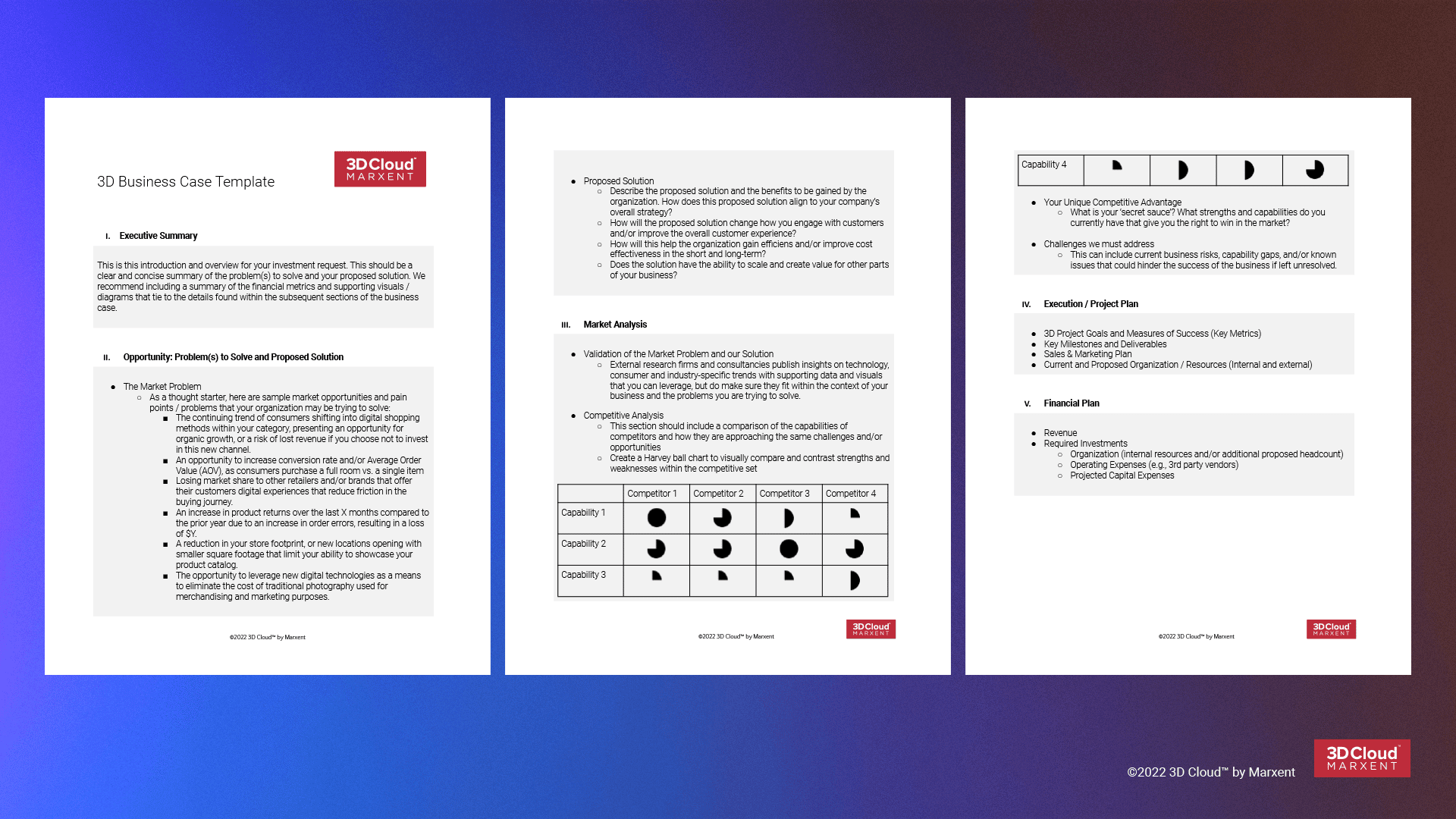Download PDF Template
Download Word Template
Learn the ins and outs of how to build a successful 3D strategy and business case. Free template download included.
This article covers:
- Why build a 3D project business case
- Must-have elements to include in your 3D project business case
- FREE DOWNLOAD: 3D project business case template
In a sea of other initiatives vying for dollars and resources, a compelling business case is the key to securing funding for new 3D initiatives.
This article and free, downloadable template will help you to get started with building a successful business case for your project.
If you’re a business unit executive, product management, digital/e-commerce, technology, or marketing leader with accountability and responsibility for securing budget dollars or a member of a project management office supporting business unit leaders, this is for you.
What is a 3D project business case?
A solid 3D project business case is a structured story of the value and opportunity – or opportunity cost – of a proposed project.
Why build a 3D project business case?
The goal of building a 3D project business case is to justify investment in a 3D project and to set the project apart from other projects competing for the same resources or budget. Senior leadership is more likely to say yes to a project that is grounded in a business case framework and that explores the opportunity. Through the lens of your executive team (CEO, CFO, CIO, etc.), what are the project(s) that will ensure a positive return and be the BEST YES for your organization?
Must-have elements of a 3D project business case
There are 4 to 5 key components to a solid 3D business case:
- Executive Summary
- Opportunity: Problem to Solve and Proposed Solution
- Market Analysis
- Execution
- Financial Plan
1. Executive summary
The executive summary provides an overview of the request for resources. This should be a clear and concise summary of the problem you intend to solve and the proposed solution.
To grab attention and create a persuasive case up front, include high-level financial metrics such as revenue goals or cost efficiencies, along with supporting visuals.
2. Opportunity: Problem to solve and proposed solution
Fall in love with the problem. Schedule a brainstorming session and get everyone involved. Focus on the key challenges, pain points, and business questions that need to be solved with urgency, and that will resonate with leadership. Find supporting data points that back up your ideas and assumptions.
- What challenges does your business face that warrants an investment in 3D?
- What are the consequences of not changing — aka ‘the burning platform’?
- What cultural, economic, and behavioral factors are in play both within the company and in the world at large?
Here are some examples of pain points:
- More people are shopping on mobile devices, but not with us.
- Customers want to self-serve more before contacting design services.
- Our average order value online is a fraction of our in-store order value.
- Losing market share to digital natives with better online shopping experiences.
- High rate of return for online purchases
- An increase in product returns over the last X months compared to the prior year due to an increase in errors in the ordering process, resulting in a loss of $Y.
- A reduction in your store footprint or new locations with smaller square footage that limit your ability to showcase your full catalog.
- New technology exists that can reduce or eliminate the cost of traditional photography for marketing and merchandising purposes.
Once you’ve clearly articulated the problem, describe the proposed solution.
- How does it align with your company’s overall strategy?
- How will it improve the overall customer experience?
- How will this help the organization gain efficiencies?
- Does the solution have the ability to scale and create value for other parts of your business?
Solutions may include 3D experiences such as Augmented Reality, 3D Product Configurator, 3D Room Planners, and/or HD Renders.
Depending on the size of your organization and the budget in play, there are a few different approaches you can take. Each has benefits.
- Request budget to launch a single solution quickly in order to learn and build a track record of delivering on business outcomes. This is faster and requires less budget upfront
- Create a roadmap for launching a complete strategy and outline the benefits and budget for the entire strategy. This requires more thought and time but can show thoroughness and build credibility.
3. Market Analysis
Back up your plan with third-party data. The market analysis section provides insight into the market dynamics, current and emerging customer trends, and competitive analysis. External research firms and consultancies publish insights on technology, consumer, and industry-specific trends with supporting data and visuals that you can use to build your case.
Consider including analysis and comparison of similar size companies or competitors in your category to illustrate a broader market perspective. Are they investing in in-house teams and capabilities for 3D content creation and 3D experiences, or have they chosen to partner with a vendor as a means to accelerate their strategy and gain a competitive edge?
Finally, include an assessment of your company’s strengths and unique competitive advantages and how this proposed solution reflects your existing business goals and company values.
4. Execution / Project Plan
“Vision without execution is hallucination” – Thomas Edison
The project plan outlines how the company will get to the proposed solution. This section should include goals and business outcomes, measures of success, key milestones/deliverables, and the resources (internal and/or external) required to execute. The plan should reflect realistic, achievable, and measurable. If you have a project management (PMO) function in your organization, that person can be a great resource for fleshing out this section.
Outline why you want to buy or partner for a solution rather than building it your own solution or, alternatively, why you want to build it in-house. Start gathering information from vendors in the space to gain insight into key considerations for project execution and resource requirements.
If the project is approved and funded, this section can be repurposed into a 3D project charter. A well-written project plan ensures consistency from strategy through to implementation and delivery.
5. Financial Plan
The best way to secure a budget is to demonstrate how the project will provide a positive return on investment. The financial plan includes an ROI model that reflects the revenue and investment assumptions based on the project goals and resources described in the project plan section.
It’s important to look at all components of the 3D project, including 3D content, maintenance, and resources required to deliver the goal. Doing due diligence on 3D content, for instance, may reveal that reusability is key to delivering on the strategy, scales to more use cases, and is worth the extra cost.
Get input from your finance team on what portion of your investment would be considered capital expenses, operating expenses, and administrative costs to fund the project.
Your financial model may not be 100% accurate as there are some risks (known and/or unknown) that could impact the project, but the financials should be realistic and account for things like business seasonality, etc.
3D business case template (download)
We’ve created a business case template to help you structure your story and case for investment in 3D. Here’s how to use it:
- Conduct research on both external and/or internal forces that support your 3D investment thesis.
- Collaborate with your finance team, project management office, and/or other stakeholders to work through project assumptions and build your financial models.
- Use this document to create your 3D project charter to share with the implementation team.
Download PDF Template
Download Word Template

A 3D project business case can provides will help you to turn your vision into a tangible project that merits funding. It’s also a great way to build internal buy-in. Involving other people in the company in the process can provide a sense of ownership over the project and serve as the foundation for success with any 3D project.
As you work on your 3D project business case and questions arise about the market, implementation, or financial assumptions, contact us to request a 3D project consultation.
Once the 3D business case is done, what’s next?
Once your 3D project business case has been circulated for internal feedback and approval, the next step is to decide whether to build your project in-house or hire a vendor. Building in-house holds appeal for major retailers with the ability to hire a large team to staff a 3D initiative, but most retailers decide to use a vendor. If you decide to use a vendor for some or all of your 3D initiative, the next step is to research vendors.
For a complete guide to launching a 3D project, visit our 3D Project Planning Resource Center.













